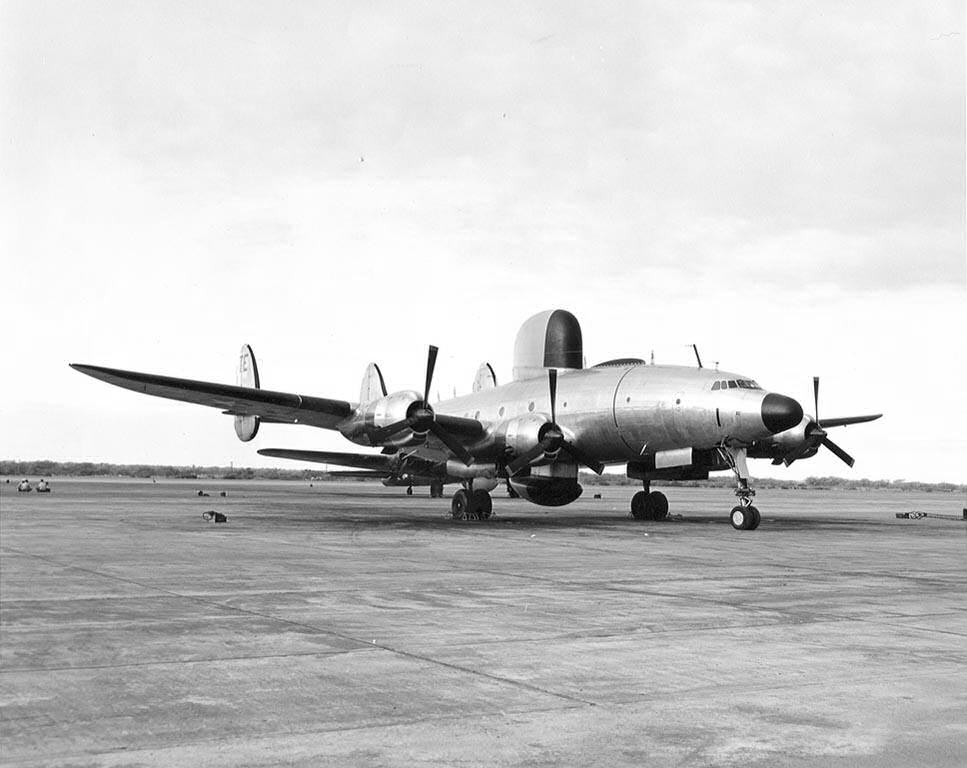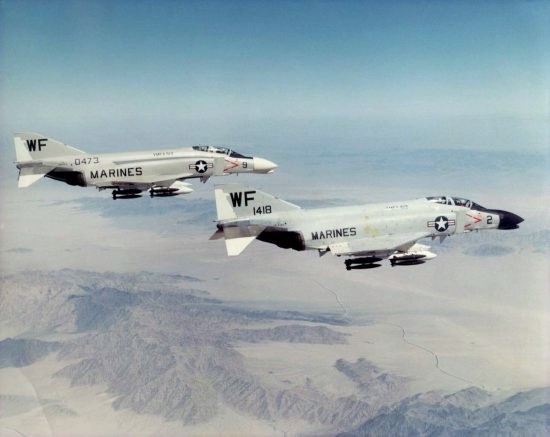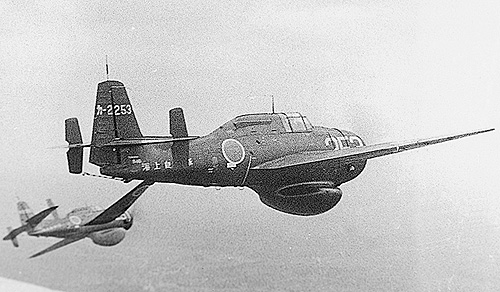|
Lockheed EC-121 Warning Star
The Lockheed EC-121 Warning Star was an American airborne early warning and control radar surveillance aircraft operational in the 1950s in both the United States Navy (USN) and United States Air Force (USAF). The military version of the Lockheed L-1049 Super Constellation was used to serve as an airborne early warning system to supplement the Distant Early Warning Line, using two large radomes (a vertical dome above and a horizontal one below the fuselage). It replaced the TBM-3W used by the USN. Some EC-121s were also used for signal intelligence gathering. The EC-121 was introduced in 1954 and phased out in 1978, although a single specially modified EW aircraft remained in USN service until 1982. The USN versions when initially procured were designated WV-1 (PO-1W), WV-2, and WV-3. The USAF Warning Stars served during the Vietnam War both as electronic sensor monitors and as a forerunner to the Boeing E-3 Sentry AWACS. USAF aircrews adopted its civil nickname, "Connie" ( ... [...More Info...] [...Related Items...] OR: [Wikipedia] [Google] [Baidu] |
WikiProject Aircraft
A WikiProject, or Wikiproject, is a Wikimedia movement affinity group for contributors with shared goals. WikiProjects are prevalent within the largest wiki, Wikipedia, and exist to varying degrees within sister projects such as Wiktionary, Wikiquote, Wikidata, and Wikisource. They also exist in different languages, and translation of articles is a form of their collaboration. During the COVID-19 pandemic, CBS News noted the role of Wikipedia's WikiProject Medicine in maintaining the accuracy of articles related to the disease. Another WikiProject that has drawn attention is WikiProject Women Scientists, which was profiled by '' Smithsonian'' for its efforts to improve coverage of women scientists which the profile noted had "helped increase the number of female scientists on Wikipedia from around 1,600 to over 5,000". On Wikipedia Some Wikipedia WikiProjects are substantial enough to engage in cooperative activities with outside organizations relevant to the field at issue. For e ... [...More Info...] [...Related Items...] OR: [Wikipedia] [Google] [Baidu] |
Vietnam War
The Vietnam War (also known by #Names, other names) was a conflict in Vietnam, Laos, and Cambodia from 1 November 1955 to the fall of Saigon on 30 April 1975. It was the second of the Indochina Wars and was officially fought between North Vietnam and South Vietnam. The north was supported by the Soviet Union, China, and other communist states, while the south was United States in the Vietnam War, supported by the United States and other anti-communism, anti-communist Free World Military Forces, allies. The war is widely considered to be a Cold War-era proxy war. It lasted almost 20 years, with direct U.S. involvement ending in 1973. The conflict also spilled over into neighboring states, exacerbating the Laotian Civil War and the Cambodian Civil War, which ended with all three countries becoming communist states by 1975. After the French 1954 Geneva Conference, military withdrawal from Indochina in 1954 – following their defeat in the First Indochina War – the Viet Minh to ... [...More Info...] [...Related Items...] OR: [Wikipedia] [Google] [Baidu] |
Naval Flight Officer
A naval flight officer (NFO) is a commissioned officer in the United States Navy or United States Marine Corps who specializes in airborne weapons and sensor systems. NFOs are not pilots (naval aviators), but they may perform many "co-pilot" or "mission specialist" functions, depending on the type of aircraft. Until 1966, their duties were performed by both commissioned officer and senior enlisted naval aviation observers (NAO). In 1966, enlisted personnel were removed from naval aviation observer duties but continued to serve in enlisted aircrew roles, while NAO officers received the newly established NFO designation, and the NFO insignia was introduced. NFOs in the US Navy begin their careers as unrestricted line officers (URL), eligible for command at sea and ashore in the various naval aviation aircraft type/model/series (T/M/S) communities and, at a senior level, in command of carrier air wings and aircraft carriers afloat and functional air wings, naval air stations and ot ... [...More Info...] [...Related Items...] OR: [Wikipedia] [Google] [Baidu] |
Georgia (U
Georgia most commonly refers to: * Georgia (country), a country in the Caucasus region of Eurasia * Georgia (U.S. state), a state in the Southeast United States Georgia may also refer to: Places Historical states and entities * Related to the country in the Caucasus ** Kingdom of Georgia, a medieval kingdom ** Georgia within the Russian Empire ** Democratic Republic of Georgia, established following the Russian Revolution ** Georgian Soviet Socialist Republic, a constituent of the Soviet Union * Related to the US state ** Province of Georgia, one of the thirteen American colonies established by Great Britain in what became the United States ** Georgia in the American Civil War, the State of Georgia within the Confederate States of America. Other places * 359 Georgia, an asteroid * New Georgia, Solomon Islands * South Georgia and the South Sandwich Islands Canada * Georgia Street, in Vancouver, British Columbia, Canada * Strait of Georgia, British Columbia, Canada United K ... [...More Info...] [...Related Items...] OR: [Wikipedia] [Google] [Baidu] |
NAS Glynco
Naval Air Station Glynco, Georgia, was an operational naval air station from 1942 to 1974 with an FAA airfield identifier of NEA and an ICAO identifier of KNEA. Now known as Brunswick Golden Isles Airport (IATA: BQK, ICAO: KBQK), it was previously known as Glynco Jetport following NAS Glynco's closure. It is a public airport located 5 miles (8 km) north of the city of Brunswick, in Glynn County, Georgia, USA. The airport has a single runway and is mostly used for general aviation, but it is also served by one commercial airline. History World War II In August 1942, the United States Navy began building the air station on in the northern part of the county. Named NAS Glynco as an abbreviation of Glynn County, Georgia, it was initially constructed as an operational base for lighter-than-air airships, more commonly known as blimps. In 14 months, workers at the new air station built two enormous wooden hangars, measuring long, wide and tall, to house an eight-ship fleet a ... [...More Info...] [...Related Items...] OR: [Wikipedia] [Google] [Baidu] |
VT-86
Training Squadron EIGHT SIX (VT-86), also known as the "Sabrehawks," is a United States Navy advanced jet training squadron based at the Naval Air Station Pensacola, Florida. Training Squadron 86 is a tenant command of Training Air Wing 6. They are a training squadron flying the T-45C Goshawk. Their tailcode is F and their radio callsign is ROKT. History Training Squadron 86 is known by several names: TRARON EIGHT SIX, VT-86, or the ''Sabrehawks'', a name derived from its history of flying the T-39D/G/N Sabreliner and the TA-4J Skyhawk II. The squadron was established on 5 June 1972, under the operational control of Commander, Training Air Wing EIGHT (TRAWING 8) at Naval Air Station Glynco, Georgia. The mission of the new squadron was to conduct advanced Naval Flight Officer (NFO) training for the U.S. Navy and U.S. Marine Corps, which had previously been overseen by Naval Air Technical Training Center (NATTC) Glynco. The training was in four areas: Radar Intercept Officer, ... [...More Info...] [...Related Items...] OR: [Wikipedia] [Google] [Baidu] |
1962 United States Tri-Service Aircraft Designation System
The Tri-Service aircraft designation system is a unified system introduced in 1962 by the United States Department of Defense for designating all U.S. military aircraft. Previously, the U.S. armed services used separate nomenclature systems. Under the tri-service designation system, officially introduced on 18 September 1962, almost all aircraft receive a unified designation, whether they are operated by the United States Air Force (USAF), United States Navy (USN), United States Marine Corps (USMC), United States Army, or United States Coast Guard (USCG). Experimental aircraft operated by manufacturers or by NASA are also often assigned designations from the X-series of the tri-service system. The 1962 system was based on the one used by the USAF between 1948 and 1962, which was in turn based on the type, model, series USAAS/USAAC/USAAF system used from 1924 to 1948. The 1962 system has been modified and updated since introduction. History The Tri-Service system was first e ... [...More Info...] [...Related Items...] OR: [Wikipedia] [Google] [Baidu] |
EC-121 Shootdown Incident
On 15 April 1969,DPRK supreme leader Kim Il-sung's 57th birthday a United States Navy Lockheed EC-121M Warning Star of Fleet Air Reconnaissance Squadron One (VQ-1) on a reconnaissance mission was shot down by a North Korean MiG-21 aircraft over the Sea of Japan. The plane crashed off the North Korean coast and all 31 Americans (30 sailors and 1 Marine) on board were killed, which constitutes the largest single loss of U.S. aircrew during the Cold War era. The plane was an adaptation of a Lockheed Super Constellation and was fitted with a fuselage radar, so the primary tasks were to act as a long range patrol, conduct electronic surveillance, and act as a warning device. The Nixon administration did not retaliate against North Korea apart from staging a naval demonstration in the Sea of Japan a few days later, which was quickly removed. It resumed the reconnaissance flights within a week to demonstrate that it would not be intimidated by the action while at the same time a ... [...More Info...] [...Related Items...] OR: [Wikipedia] [Google] [Baidu] |
AN/APS-20
The AN/APS-20 was an airborne early warning, anti-submarine, maritime surveillance and weather radar developed in the United States in the 1940s. Entering service in 1945, it served for nearly half a century, finally being retired in 1991. Initially developed at Massachusetts Institute of Technology (MIT) under ''Project Cadillac'', the radar was developed to be carried by aircraft to extend the sensor range of ships by placing a radar at altitude. Although developed for carrier-borne operation, first being installed in the single-engined General Motors TBM-3W Avenger, it was also used in larger four-engined airframes, the last being a fleet of Avro Shackleton AEW.2 which were converted from maritime patrol aircraft. Similarly, although developed for detecting aircraft, it saw extensive service in anti-submarine and maritime patrol roles and was one of the first radars to be used in researching extreme weather like hurricanes by agencies like the Environmental Science Services Ad ... [...More Info...] [...Related Items...] OR: [Wikipedia] [Google] [Baidu] |
Federal Aviation Agency
The Federal Aviation Administration (FAA) is the largest transportation agency of the U.S. government and regulates all aspects of civil aviation in the country as well as over surrounding international waters. Its powers include air traffic management, certification of personnel and aircraft, setting standards for airports, and protection of U.S. assets during the launch or re-entry of commercial space vehicles. Powers over neighboring international waters were delegated to the FAA by authority of the International Civil Aviation Organization. Created in , the FAA replaced the former Civil Aeronautics Administration (CAA) and later became an agency within the U.S. Department of Transportation. Major functions The FAA's roles include: *Regulating U.S. commercial space transportation *Regulating air navigation facilities' geometric and flight inspection standards *Encouraging and developing civil aeronautics, including new aviation technology *Issuing, suspending, or revoking ... [...More Info...] [...Related Items...] OR: [Wikipedia] [Google] [Baidu] |
Lockheed L-749 Constellation
The Lockheed L-749 Constellation is the first Lockheed Constellation to regularly cross the Atlantic Ocean non-stop. Although similar in appearance to the L-649 before it, the L-749 had a larger fuel capacity, strengthened landing gear, and eventually weather radar. Design and development In early 1947, the Lockheed Aircraft Corporation unveiled the L-749, a derivative of its L-649 Constellation with fuel tanks to increase its maximum range by . Due to the increased weight, the landing gear and tires had to be strengthened. Jet stacks were also introduced, increasing speed by . These jet stacks increased the noise, requiring more insulation. As with the L-649, ten different layouts of the internal cabin were possible. Airlines originally attracted to the L-649 changed their orders to the L-749. The L-749 was to become the standard version of the regular Constellation.Breffort, ''Lockheed Constellation'', pp. 40-45. [...More Info...] [...Related Items...] OR: [Wikipedia] [Google] [Baidu] |
Lockheed C-69 Constellation
The Lockheed C-69 Constellation was a four-engined, propeller-driven military transport aircraft developed during World War Two. It was co-developed with the Lockheed Constellation airliner. It first flew in 1943, and production of the 22 constructed was shared between the United States Army Air Forces (15) and commercial carriers. Most of the C-69 aircraft built were later converted into civilian airliners under the designation Lockheed L-049 Constellation.Breffort, Dominique. Lockheed Constellation: from Excalibur to Starliner Civilian and Military Variants. Paris: Histoire and Collecions, 2006. Print. . p. 11 to p. 17. Design and development Following the Attack on Pearl Harbor and the United States entering World War II, the assembly lines at the Lockheed Aircraft Corporation were taken over by the American government for the war effort. Along with the assembly lines, the Lockheed L-049 Constellation airliner was also requisitioned and redesignated C-69 and was to be used as ... [...More Info...] [...Related Items...] OR: [Wikipedia] [Google] [Baidu] |







